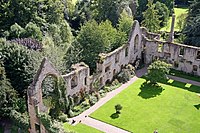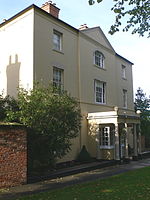Southwell
- This article concerns Southwell in Nottinghamshire. For the village on Portland see Southwell, Dorset
| Southwell | |
| Nottinghamshire | |
|---|---|
| File:Southwell minster.jpg Southwell Minster | |
| Location | |
| Location: | 53°4’12"N, -0°57’0"W |
| Data | |
| Population: | 6,900 ((approx)) |
| Post town: | Southwell |
| Postcode: | NG25 |
| Dialling code: | 01636 |
| Local Government | |
| Council: | Newark and Sherwood |
| Parliamentary constituency: |
Newark |
Southwell (pronounded ˈsʌðəl) is a town in Nottinghamshire. It is best known as the site of Southwell Minster, the cathedral of the Diocese of Southwell, which covers Nottinghamshire. Its population is about 6,900.
The town
As the site of Church of England cathedral, Southwell is sometimes considered to be a city, but such status is not recognised by the Crown.
Southwell is a visibly affluent town when compared with its near neighbours, Newark-on-Trent and Mansfield. While agriculture and coal respectively have seen the fortunes of the other two towns fluctuate over the years, Southwell has remained a residence for many of the county's wealthier residents.
The town lies on the River Greet, some 14 miles northeast of Nottingham. In addition to the Minster (the cathedral and parish church of St Mary of Southwell), there are a number of other historic buildings in the town, notably the impressive prebendal houses along Church Street and Westgate, and the town's Methodist church, which has the unusual feature of an old right-of-way running underneath it, necessitating a considerably larger upstairs than downstairs seating capacity.
Bramley apples
The Bramley cooking apple originates in Southwell; it was first seeded by Mary Ann Brailsford in 1809.[1] A local nurseryman Henry Merryweather,[2][3] at 17 years old, saw its potential and cultivated the Bramley from cuttings. The apple is now used across the cookery world, and is renowned for its sweet taste.
One of the local football clubs, Southwell City, is nicknamed "The Bramleys", and the town's new library and youth centre is known as 'The Bramley Centre' in honour of the town's contribution to British cuisine. In March 2009, a stained glass window was installed in Southwell Minister, commemorating the 200th anniversary of the Bramley.[4]
Name
The town's name is of Anglo-Saxon origin but needs no interpretation. A number of locations around the town stake claim to being the original "south well", most notably at a well site where a plaque exists; though also the Admiral Rodney pub claims it, as does a well on the south side of the Minster itself, which in the 19th century was called the "Lady Well", and one to the right of the cloisters, hitherto called Holy Well.
Norwell (pronounced "Norrell") lies some 8 miles northwest, which may support the notion of there being original "south" and "north" wells in the area.

History
Early history
A very large and opulent Roman villa excavated beneath the Minster and its churchyard in 1959[5] bears witness to a Roman presence in the area. The villa had a mural whose remaining part is now on display in the Minster. This villa is one of only three examples of its type to be found in the territories of the Coritani tribes - along with Scrampton in Lincolnshire and Norfolk Street in Leicestershire.
A section of the Fosse Way runs on the opposite bank of the River Trent with evidence of a Roman settlement having been found at Ad Pontem ("at the bridge"), northwest of the current village of East Stoke. Several Roman bricks are found to have been used in the construction of some of the prebendary buildings around the Minster, remains of a fosse or ditch having been found on Burgage Hill in the 19th century and conjecture that there may be additional Roman remains beneath the Church Street site of the recently vacated Minster School.
The Venerable Bede records the baptism by Paulinus of numerous converts in the "flood of the Trent" near Tiovulginacester in the presence of Edwin of Northumbria whom he had converted to the faith in 627. There is no agreement on the exact location of Tiovulginacester, but Paulinus certainly visited the area, and it is possible that he founded the first church in Southwell.
It is believed that this predecessor of the existing Minster existed in Anglo-Saxon times, as it is thought the remains of Eadburh of Repton, Abbess of Repton, and daughter of Ealdwulf of East Anglia are buried there.[6] She became Abbess of Repton under the patronage of her King Wulfhere of Mercia, who was the husband of her second cousin, Eormenhild. She appears in the Life of Guthlac and is believed to have died around 700 AD, her remains being buried or later translated to Southwell Minster, where her relics were revered in the Middle Ages - "There resteth St. Eadburh in the Minster of Southwell near the water called the Trent".
King Eadwig granted land in Southwell to the then Archbishop of York, Oskytel in 956 and there is evidence today in the tessellated floor and the 11th century tympanum (architecture)|tympanum over a doorway in the north transept of the construction of the Minster from this time. This charter made by Eadwy is the first firmly dated reference to Southwell. The Domesday Book of 1086 has much detail of an Archbishop's Manor in Southwell.
The Middle Ages
From shortly after that period, a custom originated known as the Gate to Southwell. In 1109, the then Archbishop of York, Thomas of Bayeux, wrote to each of the parishes in Nottinghamshire asking them to contribute to the building of the new mother church in Southwell. The proposal was agreed and each year at Whitsuntide the Mayor of Nottingham and representatives from every parish in the county would carry their contribution, known as the Southwell Pence, to the Minster to help pay for its upkeep. The procession, travelling on horseback or foot with much singing and dancing from the accompanying crowds, would set off from the Old Market Square in Nottingham headed by the Mayor and Corporation in their best ceremonial robes. Following on behind were the clergy, who used the occasion to catch up on church business, and lay people combining a pilgrimage with a holiday excursion to Southwell's grand Whitsun Fair. The Southwell Pence itself was paid in at the north porch of the Minster being received by the Chapter Clerk. The curious name of this custom - the Southwell Gate - derives from the Scandinavian word “gata” meaning street or way to and in its original form it persisted well into the 16th century. In 1981 Dolphin Morrismen, a local Morris dance side, revived the tradition which survives to this day.
In 1189 Geoffrey Plantagenet came to Southwell to take up priest's orders; and on 4 April 1194, King Richard I along with the King of Scots, William I, was in Southwell, having spent Palm Sunday in nearby Clipstone. The regal connections continued with multiple visits by King John between 1207 and 1213, ostensibly for the hunting in nearby Sherwood Forest, but also en-route with his troops on an expedition to Wales in 1212.
From 1300 to 1800
The building that is now called the Saracen's Head was originally built in 1463, after the land on that site had been granted in 1396 by the then Archbishop of York, Thomas Arundel, to John and Margaret Fysher. When built, the first floor overhung the roadway in the vernacular of the time. The ground floor had subsequently been faced up to be flush with the floor above, but the original wall lines are still visible just inside the main arched entrance, along with the original half-timbered frontage.
In 1603, James VI of Scotland travelled through Southwell on his way to London to ssume his new throne as King James I of England.
The town featured on a number of occasions during the English Civil War, perhaps most notably the fact that King Charles I spent his last night as a free man in the public house now called the Saracen's Head, but then called The King's Head in May 1646, before surrendering to the Scottish Army stationed at nearby Kelham. The fabric of the town and especially the Minster and Archbishop's Palace suffered at the hands of Oliver Cromwell's troops, as they sequestered the Palace as stabling for their horses, broke down the monuments, and ransacked the graves for lead and other valuables. As late as 1793, iron rings fastened to the walls to secure their horses to, were still in existence. The end of the civil wars left the original Archbishop's Palace in the ruinous state that can be still seen today, although the Great Hall remains. It is reputed that Cromwell also stayed in the King's Arms - in the very same rooms as Charles I.
In 1656, the original Bridewell was built on the Burgage, and enlarged in 1787 as it became a prison for the county at large. There is also evidence, however, that a house of correction was built in the same area in 1611, so the Bridewell may itself have been an enlargement. Towards the end of this period in Southwell's history, two as yet insignificant, but soon to be important persons in its heritage were born: Mary Ann Brailsford, baptized at Southwell in May 1791, and Matthew Bramley in 1796 in Balderton.
The 19th century and later

By 1801, the population of Southwell was 2,305. In 1803, Lord Byron began his brief flirtation with Southwell, staying with his mother in Burgage House during his holidays from Harrow School and then the University of Cambridge. His mother rented the house; although by that time he had become 6th Baron Byron of Rochdale, the family home of Newstead Abbey required significant remedial work, which they could not afford.
References
- ↑ Martin, J (2004) "Brailsford, Mary Ann". In Oxford Dictionary of National Biography. Oxford, Oxford University Press, Vol 7 p. 289
- ↑ http://www.bramleyapples.co.uk/cooking_apples.html bramleyapples.co.uk
- ↑ Merryweather, Roger, 1982, The Bramley: A World Famous Cooking Apple, Newark and Sherwood DC, Nottinghamshire.
- ↑ http://www.newarkadvertiser.co.uk/template/temp1.asp?id=3d0cd852-65bb-102c-aaed-89f42bfb691d
- ↑ Daniels, C. M. "Excavations on the site of the Roman Villa in Southwell, 1959", Transactions of the Thoroton Society of Nottinghamshire, Vol. 70, 1966, pp 13-33
- ↑ Rollason, D. W., "List of Saints' Resting Places in Anglo-Saxon England", Anglo-Saxon England 7, 1978, p. 89
- Arundel, Betty M., "Southwell - A History Walk", The Southwell Civic Society, 2001
- Barry, F.R., "Period of my Life (Bishop of Southwell)", Hodder & Stoughton, 1970
- Beaumont, R.M. "A Flash of Lightning on Guy Fawkes Night, 1711: The Fire at Southwell Minster", The Thoroton Society, 1973
- Beaumont, R.M. "The Chapter of Southwell Minster, a Story of 1,000 years", Unknown Publisher, 1956
- Bishop, M., "An Archaeological Resource Assessment of Roman Nottinghamshire", EMARF, unknown date
- Boyes, M., "Love without wings: The story of the unique relationship between Elizabeth Bridget Pigot of Southwell and the young poet, Lord Byron", J.M. Tatler & Son, 1988
- Buckler, J. "The Collegiate Church of Saint Mary, Southwell", Bermondsey, 1810
- Clark, T.H. "The History and Antiquities of Southwell Collegiate Church", J. Whittingham, 1838